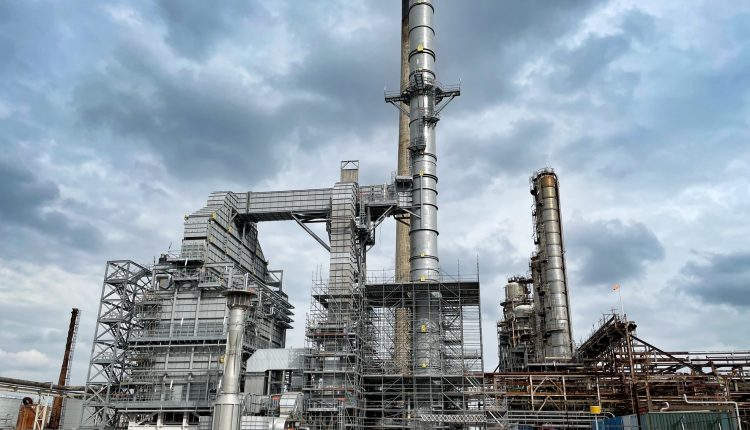
Special report: Stanlow oil refinery close to the Mersey is the epicentre of a £3bn hydrogen hub and owner Essar Oil UK will leverage that in a bid to become the world’s first decarbonised refinery. Tony McDonough reports

A decarbonised oil refinery may seem oxymoronic but Richard Holden sees no contradiction.
Richard is a project manager at Stanlow oil refinery at Ellesmere Port, a sprawling complex close to the River Mersey. He is overseeing the biggest transformation of the site in its 100-year history.
“Stanlow produces about 2m tonnes a year of CO2 which makes it the biggest emitter in the region and a prime candidate for decarbonisation,” said Richard in an interview with LBN.
“Our definition of a decarbonised refinery would effectively mean stopping all those CO2 emissions going into the atmosphere. It actually goes beyond net zero because net zero implies you are still producing emissions and offsetting them.
“There is an exponential curve. We are not going to get all the way to zero but we expect to get right down below 10% of that number.”
Stanlow is the nerve centre of the Government-backed HyNet hydrogen project. Comprising multiple partners, it will produce hydrogen for large industrial clients such as glassmaker Pilkington, consumer products giant Unilever and glass container manufacturer Encirc.
Infrastructure costs for the project will be around £18bn with operating expenditure up to 2050 estimated to be in the region of £30bn. The Government hopes it will make a big contribution to the UK’s net zero carbon targets.
In the last few days a collaboration of industry leaders, politicians and academic backed the Net Zero North West. This is aimed at making the North West the world’s first net zero cluster.
It claims it will create and safeguard more than 600,000 jobs, while highlighting the action needed to substantially decarbonise regional industry by 2030 and achieve net zero emissions by 2040.
This roadmap includes plans for greater energy efficiency, nuclear energy generation and improved rail infrastructure, enabling the region to lead the UK’s charge in tackling climate change.
Stanlow will be home to a hydrogen production hub, costing up to £3bn. It will comprise two initial hydrogen production facilities built by EET Hydrogen, a joint venture between refinery owner Essar Oil UK and low carbon energy firm Progressive Energy.
HPP1 is the first facility. It secured planning consent from Cheshire West and Cheshire Council in January. Subject to a Government funding announcement in September, work will begin on HPP1 in 2025.
It is expected to be operational by late 2027, producing 350MW of hydrogen. This will be followed a year or two later by the bigger HPP2 which will produce 1GW of hydrogen. So far only outline planning permission has been secured for this second facility.
Stanlow will also be the location for a carbon capture plant, an entity that is key to the whole HyNet project. HPP1 and HPP2 will produce hydrogen by burning natural gas from either the local network, operated by Cadent, or from the national gas grid.
Natural gas is, of course, a fossil fuel. Burning it generates CO2 emissions, a major cause of rising global temperatures and climate change.
Overseen by another company, Eni, the CO2 generated by the hydrogen plants at Stanlow will be captured and sent by pipeline to Liverpool Bay where it will be securely stored in porous rock in depleted gas fields.
However, there remains significant scepticism about the viability of carbon capture and storage. There are some who believe it simply won’t work. But more of that later.
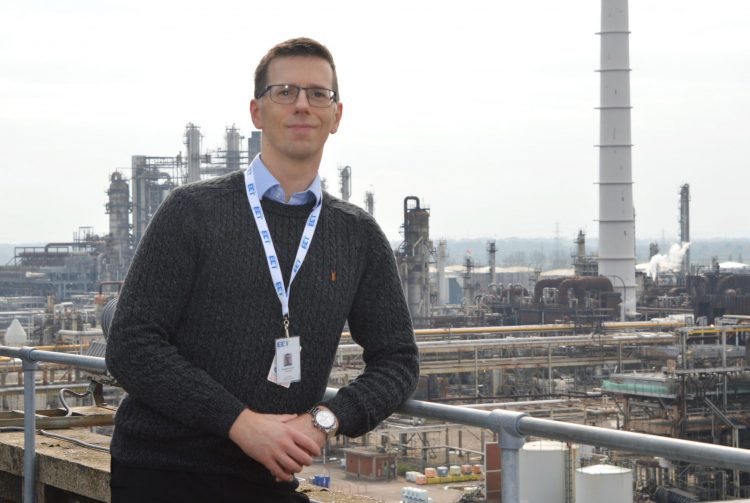
Decarbonisation of Stanlow
In 1924 Shell established a bitumen plant at Stanlow but it wasn’t until the early 1970s that the site became a major oil refinery. Shell struggled to make a profit from the refinery and sold it to Indian conglomerate Essar Group in 2011.
Essar invested more than £700m into seven square kilometre site and made it profitable. And it was all going pretty well until COVID hit in 2020 and the refinery suddenly faced an existential crisis.
Lockdowns sent demand for fuel plummeting which had a devastating effect on Essar Oil UK’s finances. A hefty HMRC bill also added to its woes. It embarked on a big drive to refinance the business, which it succeeded in doing to the tune to £1bn.
Recovery has been strong with annual revenues back above £9bn and a return to profit. Stanlow is strategically important. It provides 16% of all UK road transport fuels and each year produces 4.4bn litres of diesel, 3bn litres of petrol and 2bn litres of jet fuel.
Employing around 750 people directly, with double that number on site when you include contractors, Stanlow is one of the biggest providers of employment in the region. Staff include firefighters and medical professionals on standby 24 hours a day.
Its presence is also heavily felt on the River Mersey, adding significantly to the volume of shipping on the estuary.
Each year more than 120 supertankers unload crude oil from all over the world at the Tranmere Oil Terminal next door to the Cammell Laird shipyard in Birkenhead. An eight-mile underground pipeline transports 28 tonnes of crude to Stanlow every day.
Once refined this oil is turned into multiple petroleum products which are transported to customers via pipelines (there is a direct pipeline to Manchester Airport), by road or on more than 500 smaller tankers that berth on the Manchester Ship Canal every year.
Stanlow produces fossil fuels, lots of them, fuels that all countries of the world are now trying to wean themselves off. However, even if we go full speed towards decarbonisation we are still going to need fossil fuels for decades to come. That is simply a reality.

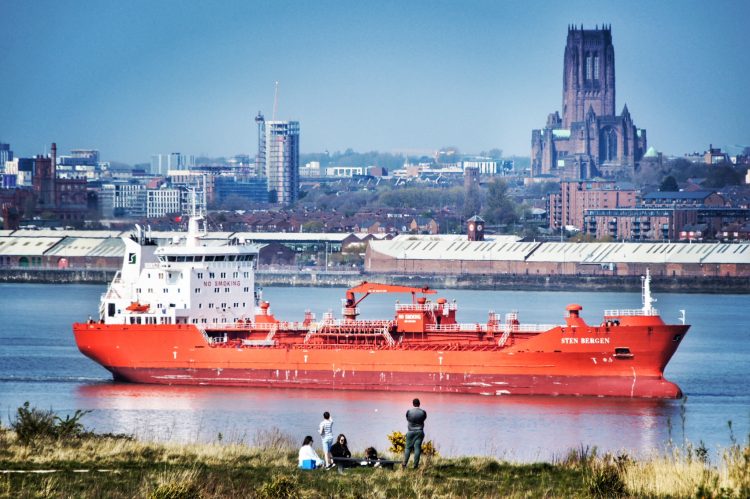
Richard Holden acknowledges the net zero transition represents the biggest challenge the energy industry has ever faced. But he sees a future where companies such as Essar become the providers of the cleaner fuels that will be critical in decades to come.
HyNet and the decarbonisation of Stanlow are two distinct projects but are inextricably linked. Richard explained: “Essar Oil UK has its own business strategy. We want to be the first decarbonised oil refinery in the world. We will definitely be one of the first.
“We have a strategy which sets out how we are going to do that and then move beyond that to create what will be a future fuels park here at Stanlow.
“And we recognise that we have a heritage in producing fuels that are required right now for the economy and for society. But they are predominantly hydrocarbon-based fuels and we realise society’s needs are going to change.
“So we want to help society move through that transition and avoid cliff edges. It is about providing a smooth transition. You don’t want businesses or supplies of fuel shutting off prematurely before other fuels are ready to take their place
“Obviously there are CO2 emissions associated with those products. You can’t get away from that. A decarbonised refinery really gives you an edge because if those products are produced in a sustainable way then you are reducing the carbon footprint.”
Under the Emissions Trading System (ETS) companies face heavy costs for emitting large amounts of CO2. This provides an incentive to decarbonise and align with investors who increasingly insist on strong ESG (environmental, social and governance) policies.
As stated at the top of this article Stanlow currently pumps 2m tonnes of CO2 into the atmosphere every year, making it one of the biggest emitters of carbon in the region.
“If the refinery is decarbonised then it is a lot more sustainable,” said Richard. “Not only from an environmental perspective but also from a business perspective.
“We will be in a very favourable position and we believe that will give us a significant advantage in the UK market. Some of the other refineries in the UK won’t have access to some of those decarbonisation moves in the same way that we have.”
Furnaces are essential to an oil refinery. The process of refining crude oil means it has to be heated to around 470 degrees celsius. Stanlow’s ‘catcracker’ furnace alone accounts for almost half of the refinery’s annual emissions.
Essar has invested £45m in a new furnace which is now installed on the site. Although it can operate using conventional fuels it is also equipped to operate using hydrogen and will do so once HyNet is up and running.
Richard added: “Hydrogen gives us the opportunity to start looking beyond the hydrocarbon market. What are the future fuels? Obviously hydrogen is one of them and we are also talking about green ammonia and sustainable jet fuel.
“All of these things come together in a place that already has the logistics and the infrastructure set up to be able to deliver those fuels to the customer. It is quite a compelling story when you put it together.”
What is your favourite colour?
Hydrogen is the most abundant element in the universe. Its potential as a clean source of fuel is immense. The snag is it has to be separated from other elements and that is an energy-intensive process, however you do it.
How hydrogen is ‘produced’ is explained using a colour-coded system. There are multiple colours but the three most commonly talked about are grey, blue and green. Whichever method you use, the end product is the same.
More than 90% of the hydrogen used in industry is currently grey hydrogen. This is hydrogen produced by burning fossil fuels such as natural gas (methane). It is the dirtiest form of hydrogen production, sending CO2 into the air in large quantities. Blue uses the same method but the CO2 is captured.
At the other end of the scale is green hydrogen. This method uses electricity produced from a renewable source, such as wind or solar, which is then fed through a machine called an electrolyzer. This separates the hydrogen atoms out in water.
From a climate change point of view this is the optimal method for producing hydrogen. However, while its development is progressing, it is a long way from being available or affordable at scale.
It also requires an abundance of renewable energy. Currently the UK has around 77GW of generating capacity with around 40% of that renewable – wind, solar, biomass and hydro.
Green hydrogen production would need access to far more capacity for it to be scalable and affordable. Green’s time will come, but probably in the 2030s.
Richard said: “Electrolyzers aren’t that big until you begin to stack them. Green is hugely important. It is the future for sure. While green is very important, the issue it has at the moment is scale.
“If you look at the first round of hydrogen allocation from Government, the electrolyzers were only producing around 10 to 20MW of hydrogen.

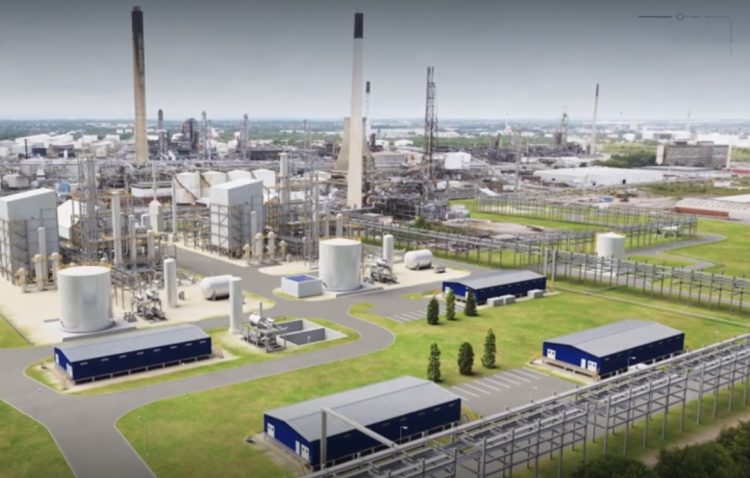
“Our first facility will be 350MW and our second will be 1,000 MW. They are orders of magnitude larger. We can deploy blue hydrogen at scale and start to tackle decarbonisation this decade.
“Electrolysers will be next decade. They will be scaling up and we will be talking about 500MW and you will see this build-out of green. It won’t supplant blue but it will work alongside it. At the end of the day it is all hydrogen. Doesn’t matter if it’s blue or green.”
HyNet is going to run small green hydrogen pilots in the North West but its main focus will be blue hydrogen. And it is in the CO2 capture and storage (CCS) where the main controversy lies.
Hydrogen is critical to the targets set as part of the Net Zero North West initiative. It is included in a £30bn pipeline of live investable projects, with the opportunity for £207bn to be invested in the region overall, all aimed at decarbonising major industrial sectors in the region.
Both of the region’s Metro Mayors – Liverpool city region’s Steve Rotheram and Greater Manchester’s Andy Burnham – are fully behind the push.
Mr Rotheram, who is also pushing a £6bn Mersey Tidal Power Scheme, said: “Climate change presents a global challenge on a scale like nothing we’ve ever seen – and it will require a huge, collective response to tackle it.
“While we had already set ourselves the ambitious aim to be net zero carbon by 2040, we are now revising our target to 2035 – the most ambitious regional target in the country.
“Overcoming climate change is not something that can be accomplished solely in our region, the UK, or even in Europe – but that won’t stop the North West doing everything we can to play the biggest part possible.”
However, CCS lies right at the heart of the strategy and, if it doesn’t work, it could derail the whole net zero timetable.
Will the project actually deliver?
In 2021 an academic report was published in the US by Robert Howarth, professor of ecology and environmental biology, and Mark Z Jacobson, professor of civil and environmental engineering at Cornell and Stanford. This was highly critical of blue hydrogen.
They warned that current CCS technology does not capture enough of the emissions to make it viable.
And they pointed to leakage of carbon from upstream methane fugitive emissions (leaks from pipes etc). Methane is itself a powerful greenhouse gas contributing to climate change.
In late 2022, Abigail Dombey, a chartered engineer and chair of Hydrogen Sussex, told LBN there were already questions over how much blue hydrogen would actually save in terms of carbon emissions.
She said: “With green hydrogen, it is simple. If we produce it from renewable sources then it is zero carbon. Blue hydrogen will never be zero carbon.. this process has still not been realised at scale.
“Even if it were feasible to capture the emissions you will never capture 100% because of the way it is produced. There has been a lot of work in the last year about fugitive emissions from natural gas as well.”
HyNet faces a high bar if it is to be declared a success. Its target of carbon capture is 97%, and not just from the actual production but from the upstream fugitive emissions referred to above.
If you point out to Richard Holden that nowhere close to 97% has ever been achieved at scale anywhere in the world he will correct you, saying: “It’s never been tried.”
In the last few days, the regulator that will oversee CCS and ensure operators hit their targets, the North Sea Transition Authority (NSTA), has issued guidance to operators on the strict criteria that will need to be met by HyNet.
“Eni is doing all of the transport and storage of the CO2,” said Richard. “We are in charge of hydrogen production and we have significant carbon capture associated with that. We give that to Eni, they put it into their pipeline and store it.
“What they are doing is taking CO2 and putting it down a hole in the ground and putting it into porous rock. That porous rock is capped. It used to contain gas and that gas had been contained there for untold millennia.
“That is the very simplistic view of it. But there is a lot of scientific study going on and it is being very closely looked at by the NSTA, which is the regulatory authority for the UK.
“They are all over this and Eni has to make a lot of submissions to them and obtain a licence to be able to do that. We will know if it works pretty quickly. There will be a series of performance tests where we will ramp the plant up and see what it can do.
“Within the contract there are very specific criteria that this plant has to meet. KPIs around the amount it captures, the thermal efficiency etc. If problems cannot be put right there will be significant financial penalties.
“It is not just us that have an interest. All the finance that will go into this means a number of interested parties will be watching these tests to make sure we meet those KPIs.
“Once we are operating the plant there will be strict reporting criteria that we will have to meet. The NSTA looks at the full chain and it has to meet a criteria of less than 20 grammes of CO2 per megajoule of hydrogen produced.
“If we meet that then the UK Government will say that each molecule of hydrogen is low carbon. It looks at everything – our operation, upstream, everything.”
On the Liverpool Bay storage, Richard added: “Just to be clear, what is under Liverpool Bay isn’t caverns, which is how some people are looking at it. These are not massive spaces. It is porous rock. Little gaps but on a massive scale.
“You pressure the CO2 down the same hole that the gas was brought up through. You have this porous rock, like a sponge, then you have this cap rock which is impermeable that is keeping the gas in place. Over time the pressure will rise until it reaches capacity.
“The great thing is when the first fields are full there are more gas fields to the north that are currently in service. When they get to the end of their life they will be usable. There are decades of storage in Liverpool Bay.
“Will it leak is the big question. But natural gas has been sitting there for millennia and only came out when we drilled a hole. As long as we cap it there is no reason the CO2 should escape.”
Helping industry hit net zero
HyNet has identified around 4GW of demand for hydrogen from industrial customers across the North West. There is a broad consensus that hydrogen is best suited to heavy industry.
A home heating pilot project for a village in Ellesmere Port was abandoned. Experts insist heat pumps are a far more efficient way of heating homes. And while hydrogen may be suitable for larger transport, electric cars have seemingly won that argument.
Hydrogen may ultimately offer the best solution for addressing the intermittency of renewables such as wind and solar. Once green hydrogen is available at scale it can provide the longer-term storage that current battery technology cannot.
“There are salt caverns under Cheshire that currently store natural gas and they will be used to store hydrogen,” said Richard. “That then gives you the dispatchable power you can deploy at very high capacity.”
He added: “What blue hydrogen enables you to do is take an existing gas that we know we already have the infrastructure for. UK industry already uses that. All we are doing is replacing that and giving them a gas that no longer emits CO2.
“I am not saying hydrogen is exactly the same as methane, but it is very similar in terms of burnability. They don’t have to change their operations to use it.”
CCCS will also offer another route via which Essar can decarbonise the Stanlow refinery. So-called refinery off-gas is a by-product of the refining process. This methane makes up about 10% of the crude oil but it is not suitable for sale so it has to be burned off.
Right now this creates more CO2 emissions but once the CCS plant is operational those emissions can also be captured and sent to Liverpool Bay to be stored.
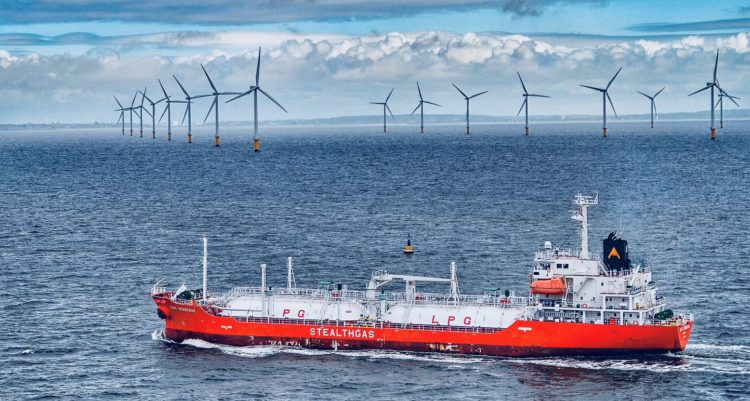
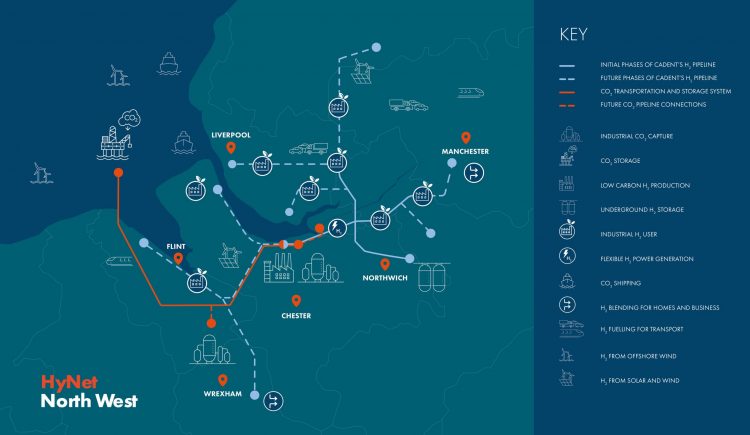
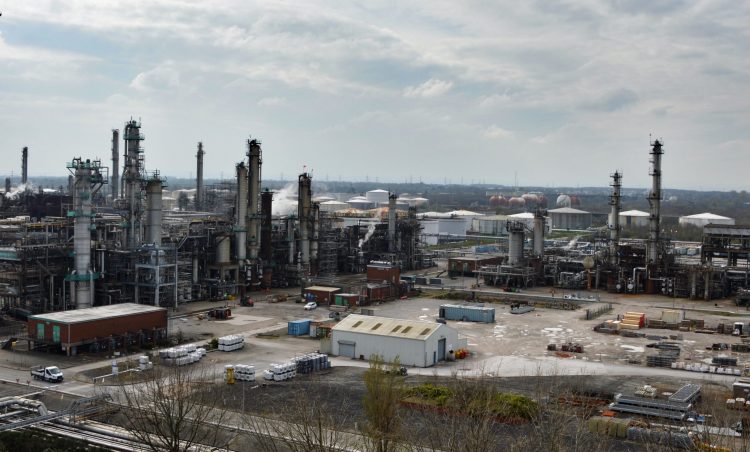
A real game-changer
A significant number of people remain sceptical whether CCS on this scale will work. Richard is not one of them. He is confident HyNet will meet its carbon capture targets and believes it will be a real game-changer in terms of the UK’s net zero ambitions.
“We will be generating 1.35GW of hydrogen once both plants are up and running which is enough to power a city the size of Liverpool,” he said.
“The North West is a great place to put HyNet for a number of different reasons. You have this massive concentration of heavy industry that is producing a lot of CO2. You have depleted gas fields very close by.
“They have a challenge in the North East because their gas fields are much further out to sea. We also have natural hydrogen storage in the salt caverns. So it all comes together really nicely here.
“We have already got agreements in place that cover the entire demand and more of our first two plants. So we are not stopping at two – we are thinking HPP3, HPP4. Not on the same site but we are going in that direction.”
READ MORE: £6bn tidal power ‘barrage across the Mersey’ takes step forward
HyNet won’t lead to a big increase in headcount at Stanlow, although there will be extra support and technical staff. Just two years on from fighting for its existence, Stanlow sees its decarbonisation plan as a way of future-proofing the site.
Richard added: “Then you look at the jobs in all the industries this will be supplying. They are currently saying CO2 emissions and fuel costs are threatening the future of their businesses. Their shareholders see ESG as hugely important.
“We are giving them an opportunity to put their investment into this region and grow here because we can provide them with low carbon fuel. And not many places in the world will be able to offer that.”
